“Unseen” Bangkok – Exploring Curious Corners Off The Beaten Track
"Unseen" Bangkok – Exploring Curious Corners Off The Beaten Track
Phayathai “Train Bar”
“We have to walk along the rail tracks for about a mile or so to get to the place. Watch out for the trains!”
Today I have decided to do some urban exploration with Chris. Chris is originally from the Netherlands and has become a resident of Bangkok relatively recently, having made the permanent move over to Thailand only about six months ago. Like so many others before him he became enthralled with the country on his first visit some years ago, and consequently decided to sell his business back home in pursuit of early retirement in “paradise”. I became acquainted with Chris through one of the online social networks I like to comb through in search of hints about curious and unfamiliar places often only locals know about.
By his own admission Chris is a train aficionado.
“Whenever I stumble upon rail tracks that cut through Bangkok and I don’t know where they are leading I have this strange urge to find out by following them” Chris had explained to me when I first interviewed him about what kind of quirky places he knows in the city. “I have surprised myself repeatedly by how many interesting places I have found by doing so!”
Exiting the Phayathai BTS station Chris and I branch off Phahon Yothin Road and follow the narrow elevated footpath next to the rail tracks heading west. We have to watch our steps because some of the longish concrete boards that make up the footpath have become loose in their sockets and tilt over if you don’t step on them right in the center. It gives the sensation of walking on an overdimensioned keyboard.
All along the way there appears to be an active community of dwellers and shop keepers. Kids are playing on and off the rail tracks, and elderly people sitting in front of their humble shacks throw us curious glances and smiles. There’s laundry left out to dry in the sun dangling from improvised wooden hangers right next to the tracks, and we even pass the boxing ring and training facilities of the neighborhood’s open-air Muay Thai gym.

|

|
Passing underneath the elevated Si Rat Express Way we approach our destination. On a previous visit to this area Chris had discovered this place and has returned several times since. If it wasn’t for its setting right next to the railway line there’d be nothing extraordinary about it. It’s a simple family-run shop selling snacks of the kind you find hundreds of thousands of all over Thailand. Outside the shop the owners have set up a little bar with stools where customers can sit and enjoy their drinks. Sitting on one of those stools one is separated by less than a meter from the trains that come passing through. There aren’t too many of them, maybe one or two per hour, but they are going at significant speed considering the fact that they are travelling through a rather densely populated area.
Trains travelling through slums and shantytowns are certainly not unique to Thailand. I have seen pictures and watched Youtube videos of trains doing just that in a number of countries in the world, yet this is the first time I get to experience this up close and personal.
Chris and I buy drinks from the lady who runs the shop and settle down on the stools. I ask her when she thinks the next train is going to come through.
“There’s a schedule” she says, but she doesn’t know it. “Even if I did know the schedule it wouldn’t be of any use as the trains are always delayed anyway” she adds and laughs out loud.
Minutes later Chris and I are joined by a local drunkard who starts babbling away at me and keeps on insisting that I take a good sip of the rice liquor he is carrying around with him in a small Thai Red Bull bottle. I politely refuse his offers with a smile, and eventually he downs the remaining two mouthfuls of liquor with large gulps and meanders off.
“Move back quickly! Move back quickly!” the shop owner shouts. Before we know it a train comes rushing by, catching both Chris and I by surprise. During the course of the three hours we spend at the “train bar” there are a total of five trains passing through.

|
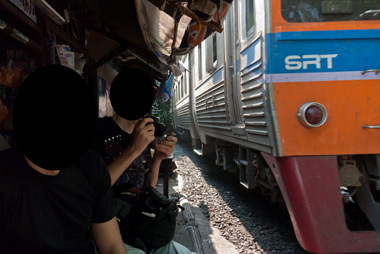
|
It may not be a unique place, and there are probably several others similar to this one in Bangkok, but I certainly enjoyed the experience and can recommend it to anyone interested in enjoying a few drinks in a somewhat unusual setting.
Makkasan Train Cemetery
Next time when you travel on the new “Airport Link” BTS line between Makkasan and Phayathai station take a careful look out the window facing north. Just below the elevated tracks of the new skytrain line there’s a large unpopulated area. At first glance it looks like a yet undeveloped building area, but in reality this compound is presently used as a train cemetery by the State Railway of Thailand. For anyone interested in old train carriages this area makes for a couple of hours of worthwhile exploration. Access is easy from both Phayathai as well as Makkasan station. There are no gates or other barriers that prevent trespassers from entering.
Chris and I entered the compound from Makkasan station and spent an interesting time exploring and photographing the old trains. Some of them are still in pretty good shape, while others are in an advanced stage of decay or even totally wrecked.
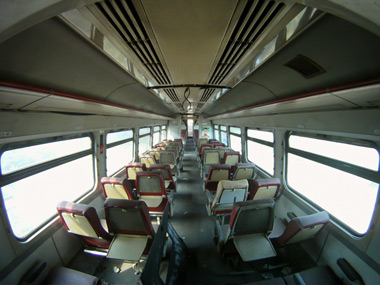
|
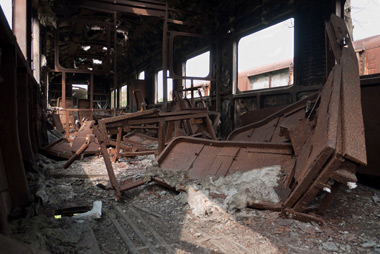
|
We had already spent two hours when we came upon a bored young security guard who was clearly startled at first, suddenly running into two tall foreigners with cameras. I briefly explained to him what Chris and I were doing there and asked if that would be a problem. I am not sure if he understood why anyone would be interested in roaming around a train cemetery, but at first he indicated that this would be okay, only to get on his walkie-talkie seconds later, apparently to ask advice from one of his superiors.
We were left alone for the next ten minutes or so until suddenly two other, clearly more senior, security officers arrived on the scene. They were friendly but less understanding, and asked us to leave the compound immediately. Chris offered a couple of hundred baht to buy us some more time, but they wouldn’t have any of it, and we were escorted off the premises.
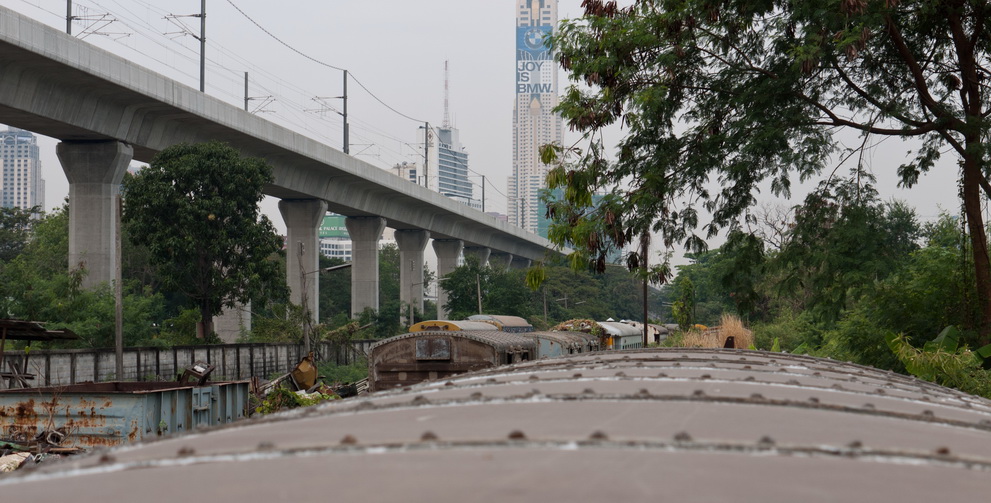
A few days later Chris told me that he tried to access the compound from the other side (Phayathai) the following day, but was spotted by the security guards very soon who reacted less friendly than the day before and chased him away by throwing rocks.
Chao Mae Tuptim Shrine
Not far from the Chitlom BTS station a little quirky shrine unlike all others I have come across in Bangkok begs for attention. Access is through the grounds of the Swissotel Nai Lert Park on Wireless Road, yet it is more advisable and far easier to head to the back entrance of the hotel which is located in Soi Somkid, a long soi that runs parallel to Wireless Road. It’s an easy ten minute walk along the soi from Sukumvit Road. The shrine itself is located on the left just past the gate of the hotel’s back entrance. It is guarded, but when I walked past the security guard with purpose he made no attempts at stopping me.
So what’s so interesting about Chao Mae Tuptim Shrine? It certainly isn’t its size, because it’s tiny. It’s not its setting either, as it’s located in a rather unattractive corner of the hotel compound right next to the parking garage. It’s the theme of the shrine that sets it apart.
Chao Mae Tuptim Shrine is a phallus shrine. Leaning against trunks of trees and rocks there are hundreds of carved wooden penises of all kinds of shapes and sizes. There are also several large penis statues made of stone, some of which rest on “legs” and resemble canons. In short, the casual visitor finds himself surrounded by a plethora of penises of all kinds of thinkable and unthinkable shapes. It’s quite a sight.
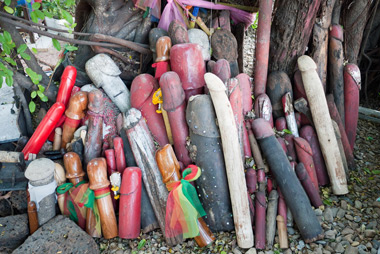
|
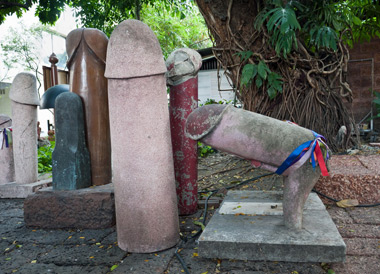
|
Chao Mae Tuptim Shrine was originally set up by famous Nai Lert (Lert Sreshthaputa) himself. Nai Lert was known as Thailand’s first and foremost developer and investor. Nai Lert certainly didn’t intend Chao Mae Tuptim to become a phallus shrine, but originally devoted it to the spirit that he believed resided in the local Ficus trees. Traditionally offerings to this shrine included pink and white lotus flowers, as well as white jasmine and incense.
According to legend things started to go astray with the theme of the shrine after a woman who had gone there to pray to become pregnant saw her wish become reality. The story goes that after the baby had come into this world she returned to the shrine and left an oversized penis as an offering of gratitude. Apparently the news about her “miraculous” impregnation spread like wildfire and over time more and more people arrived to the shrine, making their own offerings in the form of giant penises.
Nang Nak Ghost Shrine
Yet another shrine with an unusual theme is located on the grounds of Wat Mahabut at the end of On Nut Soi 7. I believe this one is better known than Chao Mae Tuptim Shrine, yet in all my visits to Bangkok I had never heard of it until recently.
What sets this shrine apart from others are once again the offerings that are being made by the many worshippers who flock to pray at it. Besides the ubiquitous offerings you can find at most other shrines and temples in Thailand, such as incense, fruits, and flowers, those most notably here also include fine dresses, cosmetics, diapers, candy, and toys. It looks more like somebody’s home than a site of ritual prayer. The television in the shrine is always kept on for the local “resident” as well. But who is she?
Mae Nak Phra Khanong, as this shrine is also known, is said to be the burial place of Thailand’s most famous ghost. The story goes that Mae Nak, a native of Phra Khanong district, married a handsome local guy called Mak. Mae Nak becomes pregnant, but before the baby gets born Mak is conscripted for military service and is forced to head to war, leaving his pregnant wife behind. Mae Nak and her child unfortunately die during childbirth and are buried by her neighbors. Because of Mae Nak’s undying love for her husband her spirit refuses to leave the house though and patiently awaits his return.
When Mak finally returns home from war where he suffered terrible injuries he finds Mae Nak just where he had left her, living in their house with their newborn son. Not realizing that his wife and son actually died, he dismisses the well-meant warnings from his terrified neighbors, and happily goes on living together with his wife and son as a family as if everything was perfectly normal.
The happiness was not meant to last though. When Mak eventually comes to his senses and realizes that his neighbors were onto something when they spoke about him living with a ghost he flees to the temple of Wat Mahabut. Mae Nak’s reaction to his is one of fury, and she starts terrorizing the whole neighborhood out of her anger and frustration about their neighbors’ interference in what she considers her personal affairs. Consequently a ghost doctor gets dispatched to her house and manages to capture her restless spirit in a jar before finally admitting her where she should have gone a long time ago, to the world of the dead. Thus Mak has found peace from his deceased wife’s ghost, yet remains heartbroken for the rest of his life.
In the shrine devoted to Mae Nak nowadays there’s a statue of her holding her child in her arms. It forms the centerpiece of the shrine. There are also several portraits of her on the walls.
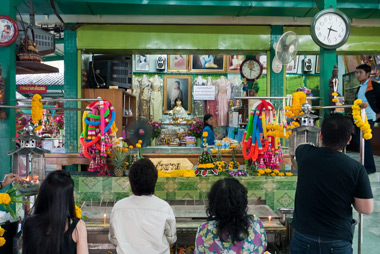
|
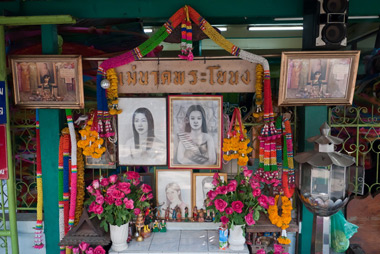
|
The shrine has become very popular with those who seek wealth, good luck, or romance. Since Mae Nak’s grief was partly caused by military conscription, she is believed to detest drafts and has thus become the patron ghost for those who want to avoid serving in the military. Young men flock to the shrine to make their offerings and pray to be excluded from the call-up. Mae Nak is also said to be very benevolent at giving out winning lottery numbers. On days before the national lottery draw the shrine bustles with fortune tellers and ticket sellers.
Bangkok Protestant Cemetery
At the end of Charoen Krueng Road Soi 72-5 there is a small metal gate leading to the grounds of Bangkok’s Protestant Cemetery. It’s only a short taxi ride from Saphan Thaksin BTS station, or an easy 20 minute walk.
This is quite a fascinating location for anyone interested in history and the lives of some of the first Westerners who arrived to the shores of old Siam to stay, live, and die in what must have struck them as such an incredibly foreign, fascinating, and mysterious land.
From about 1850AD more and more protestant Christians arrived to the kingdom to leave their footprints on society, and before long there was also the need for them to have their own burial ground. The land for the cemetery was consequently donated by Rama IV.
This need for burial space was increased by the actions of Rama V, who famously opened the country to Western modernization and progress and invited a significant number of foreign engineers and scientists to his kingdom to aid with these efforts. Many of those early foreign visitors to Siam who had high positions in the government and acted as royal advisers are still buried on the Protestant Cemetery today.
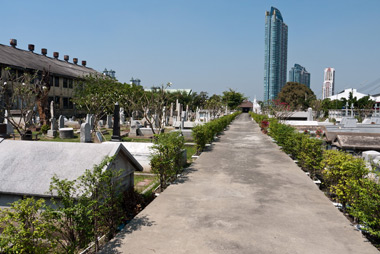
|
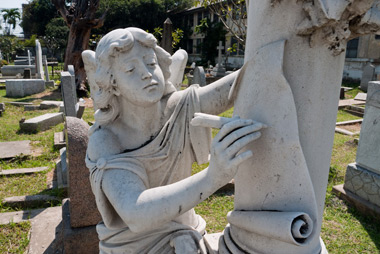
|
Amongst others, one of the more prominent people who are buried here is George Bradley Mc Farland, who became famous for publishing the first comprehensive Thai-English dictionary in 1941 after spending 16 years on researching and writing it. Not long after his dictionary was published, George was interned by the Japanese occupation forces and found his death in captivity in 1942. In the headstone of his grave George’s rank as a royal minister is mentioned, as well as his Thai name.
Then there is the grave of Daniel Beach Bradley, who was an American missionary. Daniel was a doctor who is credited with having introduced modern Western medicine to Thailand. He also devised the first Thai-script printing press, consequently publishing the first Thai newspaper and monolingual Thai dictionary.
Henry Alabaster’s grave is probably the most impressive in the cemetery. Henry served as a royal advisor to the king, who also paid for and constructed the impressive memorial that marks the location of his grave. He was a civil engineer who laid out Silom Road and Charoen Krueng Road, amongst many others.
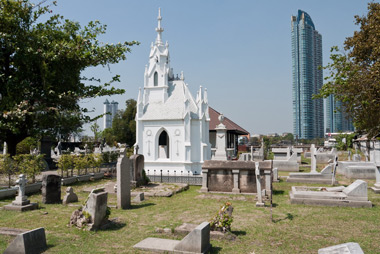
|
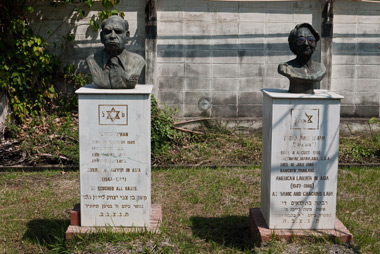
|
There are a number of Jewish graves as well, since before 1997 no other place in the city existed for the Jewish community to bury their dead.
If you know of any quirky places in Bangkok I’d appreciate you sending me an email, or writing up your own submission about them.
Stickman's thoughts:
Wonderful and I too would like to encourage others to share any of their favourite places in Bangkok. Maybe if there was enough interest we could even organise some small groups to visit such places? That would be a much more enjoyable way to meet readers and submission writers than over a beer in a noisy bar.



